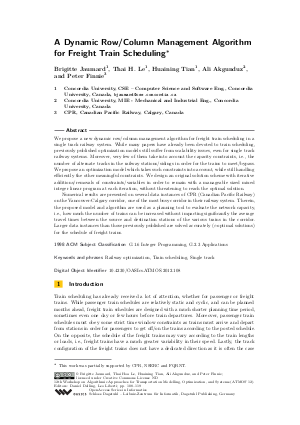A Dynamic Row/Column Management Algorithm for Freight Train Scheduling
Authors Brigitte Jaumard, Thai H. Le, Huaining Tian, Ali Akgunduz, Peter Finnie
-
Part of:
Volume:
12th Workshop on Algorithmic Approaches for Transportation Modelling, Optimization, and Systems (ATMOS 2012)
Part of: Series: Open Access Series in Informatics (OASIcs)
Part of: Conference: Symposium on Algorithmic Approaches for Transportation Modelling, Optimization, and Systems (ATMOS) - License:
 Creative Commons Attribution-NoDerivs 3.0 Unported license
Creative Commons Attribution-NoDerivs 3.0 Unported license
- Publication Date: 2012-09-13
File

PDF
OASIcs.ATMOS.2012.108.pdf
- Filesize: 0.88 MB
- 12 pages
Document Identifiers
Subject Classification
Keywords
- Railway optimization
- Train scheduling
- Single track
Metrics
- Access Statistics
-
Total Accesses (updated on a weekly basis)
0PDF Downloads0Metadata Views
Abstract
We propose a new dynamic row/column management algorithm for freight train scheduling in a single track railway system. While many papers have already been devoted to train scheduling, previously published optimization models still suffer from scalability issues, even for single track railway systems. Moreover, very few of them take into account the capacity constraints, i.e., the number of alternate tracks in the railway stations/sidings in order for the trains to meet/bypass. We propose an optimization model which takes such constraints into account, while still handling efficiently the other meaningful constraints. We design an original solution scheme with iterative additions/removals of constraints/variables in order to remain with a manageable sized mixed integer linear program at each iteration, without threatening to reach the optimal solution. Numerical results are presented on several data instances of CPR (Canadian Pacific Railway) on the Vancouver-Calgary corridor, one of the most busy corridor in their railway system. Therein, the proposed model and algorithm are used as a planning tool to evaluate the network capacity, i.e., how much the number of trains can be increased without impacting significantly the average travel times between the source and destination stations of the various trains in the corridor. Larger data instances than those previously published are solved accurately (epsilon-optimal solutions) for the schedule of freight trains.
Cite As Get BibTex
Brigitte Jaumard, Thai H. Le, Huaining Tian, Ali Akgunduz, and Peter Finnie. A Dynamic Row/Column Management Algorithm for Freight Train Scheduling. In 12th Workshop on Algorithmic Approaches for Transportation Modelling, Optimization, and Systems. Open Access Series in Informatics (OASIcs), Volume 25, pp. 108-119, Schloss Dagstuhl – Leibniz-Zentrum für Informatik (2012)
https://doi.org/10.4230/OASIcs.ATMOS.2012.108
BibTex
@InProceedings{jaumard_et_al:OASIcs.ATMOS.2012.108,
author = {Jaumard, Brigitte and Le, Thai H. and Tian, Huaining and Akgunduz, Ali and Finnie, Peter},
title = {{A Dynamic Row/Column Management Algorithm for Freight Train Scheduling}},
booktitle = {12th Workshop on Algorithmic Approaches for Transportation Modelling, Optimization, and Systems},
pages = {108--119},
series = {Open Access Series in Informatics (OASIcs)},
ISBN = {978-3-939897-45-3},
ISSN = {2190-6807},
year = {2012},
volume = {25},
editor = {Delling, Daniel and Liberti, Leo},
publisher = {Schloss Dagstuhl -- Leibniz-Zentrum f{\"u}r Informatik},
address = {Dagstuhl, Germany},
URL = {https://drops.dagstuhl.de/entities/document/10.4230/OASIcs.ATMOS.2012.108},
URN = {urn:nbn:de:0030-drops-37074},
doi = {10.4230/OASIcs.ATMOS.2012.108},
annote = {Keywords: Railway optimization, Train scheduling, Single track}
}
